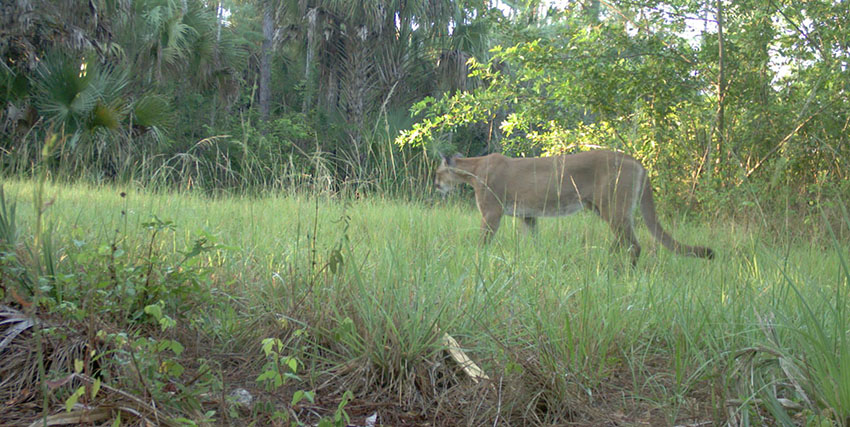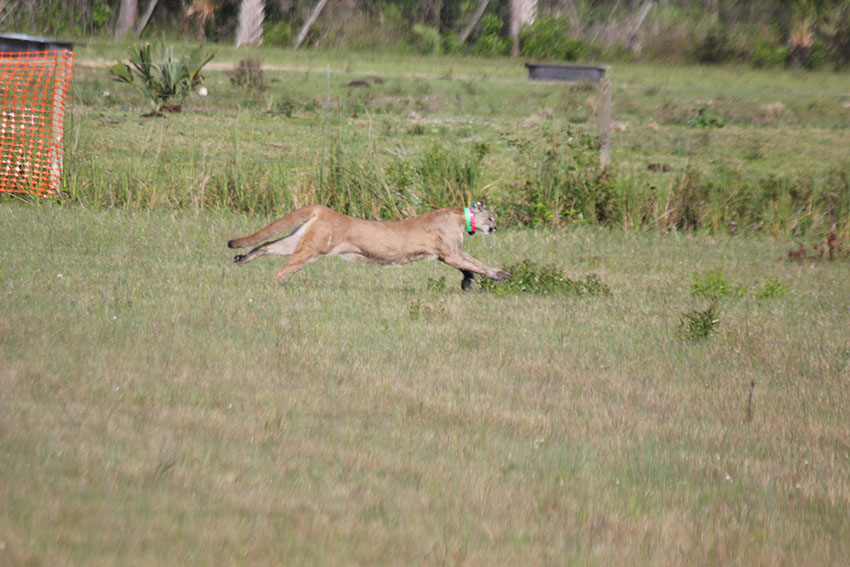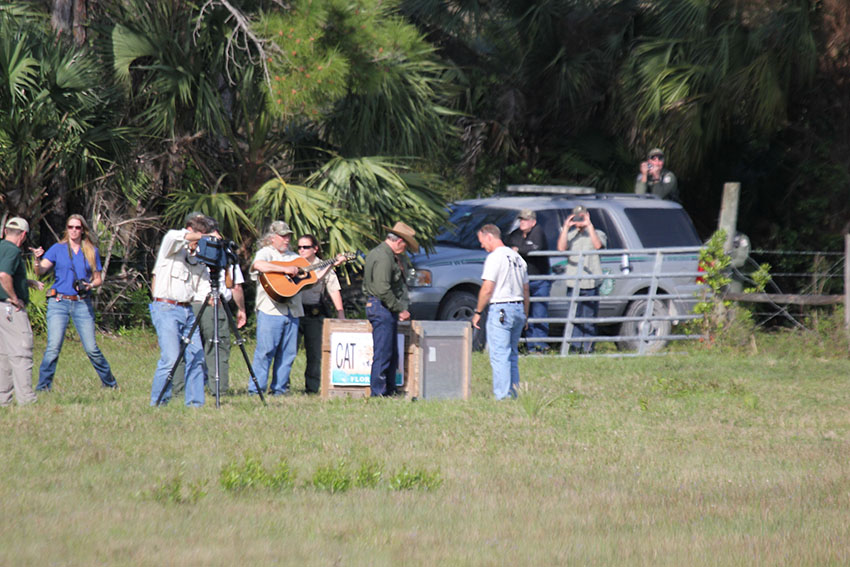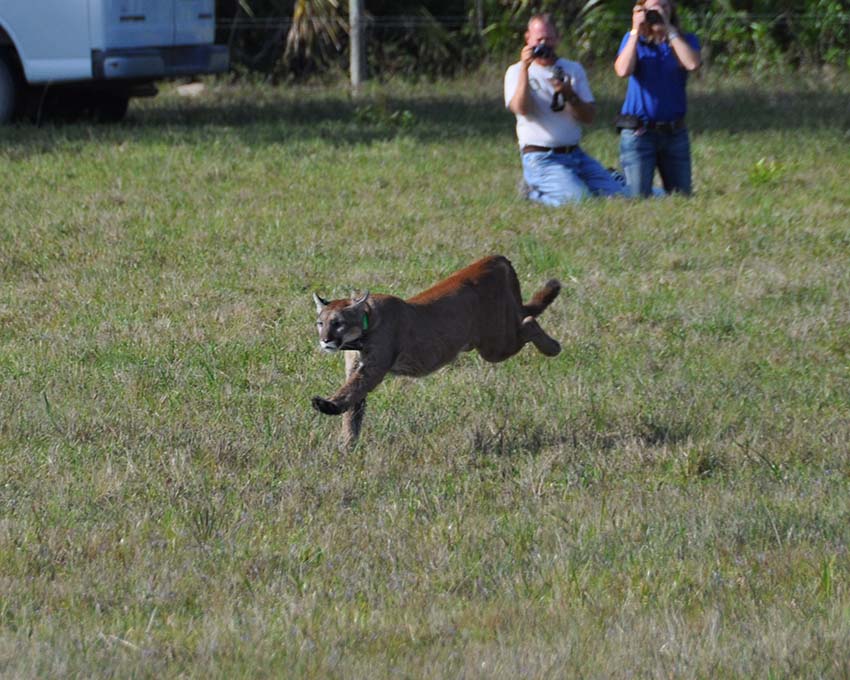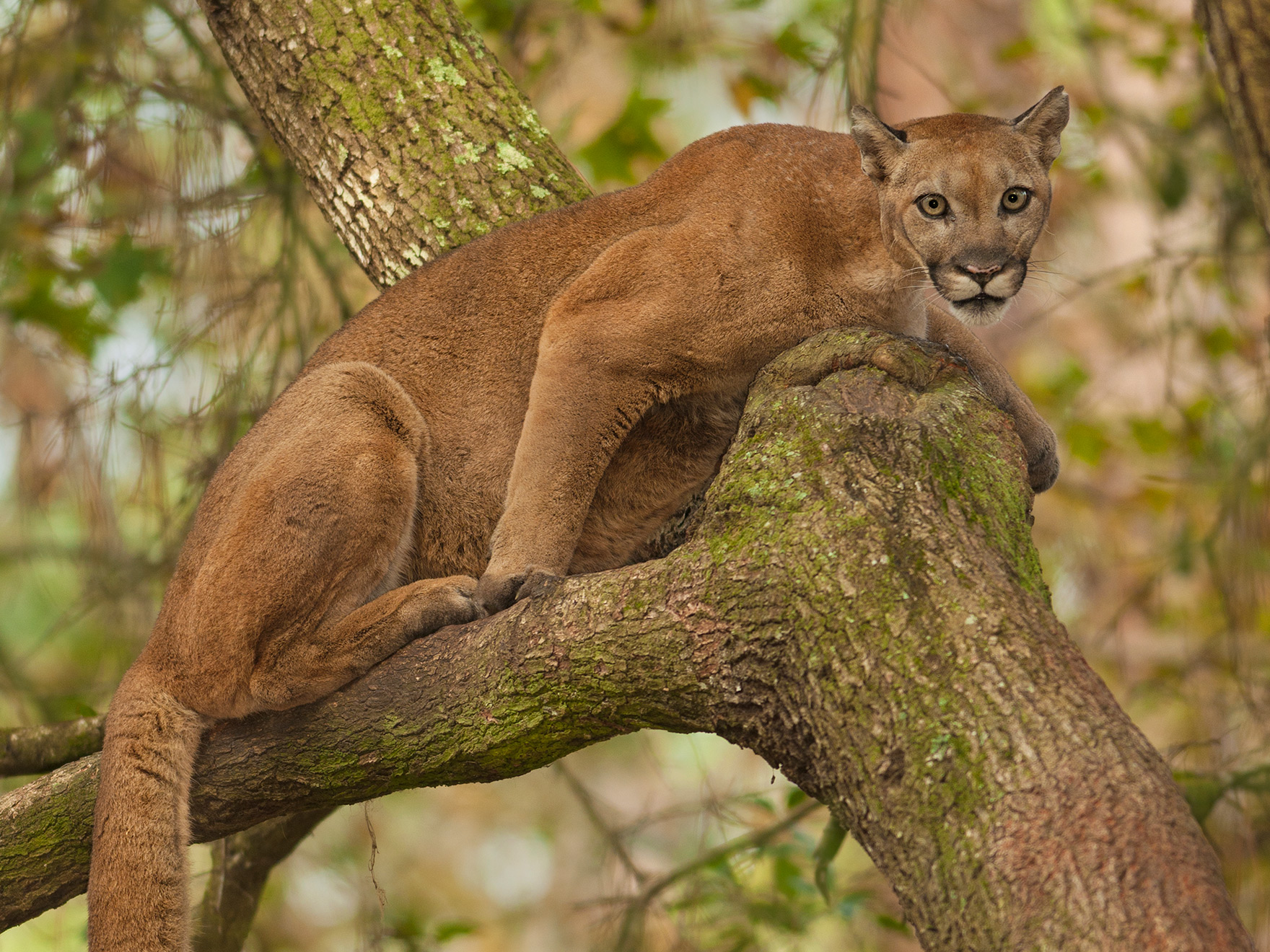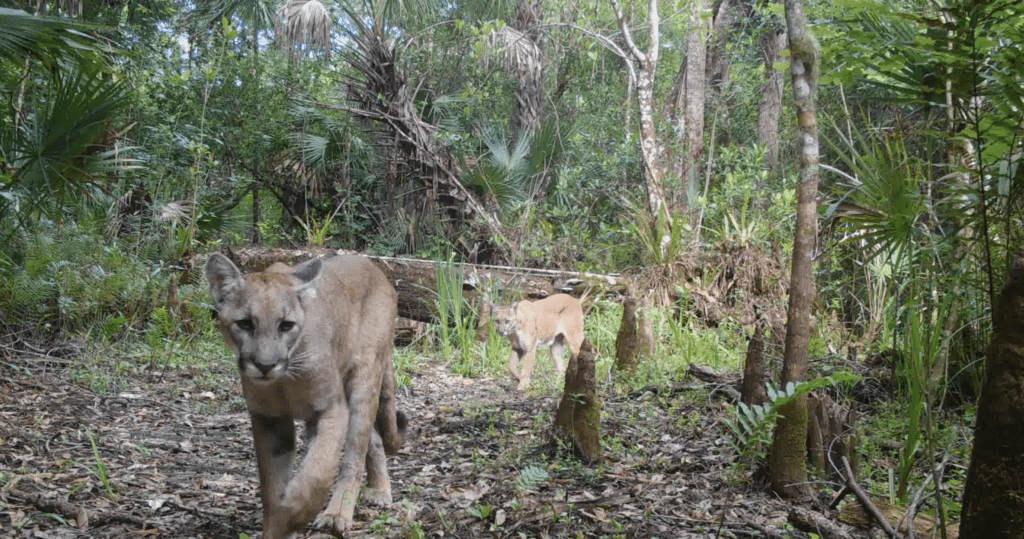Geographic Range & Habitat:
This subspecies of panther was once found throughout the southeastern United States, from Arkansas and Louisiana west to South Carolina, and further south into Florida. Today, it is best known as the “Florida” panther, and is found in only < 5% of its former range; a single population here in south Florida. Florida panthers inhabit a range of ecosystems in the Everglades, from upland pine habitat to mixed/cypress swamp, with a preference for forested cover to hide and hunt. Florida panthers are solitary and require an immense home range.
Although Florida panthers are found throughout much of the Greater Everglades wetlands, most panther sightings occur near the Florida Panther National Wildlife Refuge within Big Cypress National Preserve (western side of the Everglades).
Appearance:
Adult Florida Panthers are relatively large, solid tan cat with a white underbelly, however the ears, tip of the tail, and areas of the muzzle are typically black. Some adult panthers have measured as long as 7 feet, with males weighing around 102-160 lbs. and females around 50-115 lbs.
Kittens are grayer in appearance with black markings on the body and tail, which fade as the kitten matures.
Diet:
Florida Panthers prey predominately on White-tailed deer and feral hogs, though there are several accounts of Florida panthers also preying upon medium-sized mammals such as raccoons, nine-banded armadillos, and domestic cats. Florida panthers will also consume the occasional small mammal (i.e. rodents or rabbits) and may hunt unsecured livestock.
Behavior:
Florida Panthers are crepuscular, meaning they are most active at dawn and dusk. Unless mating, or raising cubs, they are solitary, with very large home ranges. Female home ranges are around 77 mi2 and for males around 166 mi2. Female Florida panther home ranges will often overlap with other females and males, whereas males only overlap around the edges of another male’s home range. Florida panthers are a quiet and shy species to humans, and spotting one in person is a rare occasion. However, Florida panthers are commonly monitored using game cameras.
Reproduction:
Female Florida Panthers reach reproductive maturity at around 1-2 years old and for males around 3 years old. Florida Panthers do not have a distinct breeding season, but males and females will spend a few days together while mating.
Females will typically have one litter of 1-4 kittens during the late spring months (Mar.-Jul.). Gestations is approximately 95 days, and kittens will often accompany their mother for up to two years.
Active research:
The Bergeron Everglades Foundation works in collaboration with Florida Fish & Wildlife Conservation Commission (FWC) and the United States Fish & Wildlife Service (USFWS) on a Florida panther monitoring project at Green Glades West.
We actively monitor 50 camera traps across Green Glades West, which is adjacent to the Big Cypress National Preserve and the Seminole Big Cypress Reservation. Each panther detection is documented, saved and sent to our state and federal partners as part of a cooperative Florida panther private land monitoring project. All cameras are accounted for via GPS coordinates and GIS mapping.
The Foundation has been able to document a number of interesting panther behaviors and even re-captured, via camera traps, particular individual panthers or family groups. Some of the behaviors we’ve documented range from vocalizations to breeding behavior, and even some active hunting.
Green Glades West sit at an important location in Florida, making it an integral part of the Florida Wildlife Corridor which protects crucial habitat for Florida panthers and other wildlife on federal, state, private, tribal, and county owned land parcels to create and preserve contiguous tract of viable habitat.
Recent:
- (2021) Impact of Pseudorabies on Florida Panther Mortality https://meridian.allenpress.com/jwd/article/57/4/784/469843/PSEUDORABIES-AUJESZKY-S-DISEASE-IS-AN
- (2021) Effects of seas level rise on Florida Panthers https://www.sciencedirect.com/science/article/pii/S1617138121000996
Ongoing:
- Florida Panthers are regularly monitored by agencies like the Florida Fish and wildlife Conservation Commission. Reporting any Florida panther sighting is encouraged to help researchers understand their range and better monitor heal3th and population status. You can report a sighting here: https://app.myfwc.com/hsc/panthersightings/
Panther Facts:
Did you know?
- In 1995, eight female pumas from Texas were released in south Florida to improve gene flow. An isolated population has a restricted number of genes leading to inbreeding, which had an overall affect on the survival of Florida panthers.
- The leading cause of Florida Panther mortality are vehicle collisions; always be mindful the speed limit in areas where Florida Panthers are known to inhabit- especially at dawn and dusk.
- No melanistic (black panthers) panthers or pumas have been documented in North or South America.
References
Caudill, G., Onorato, D. P., Cunningham, M. W., Caudill, D., Leone, E. H., Smith, L. M., & Jansen, D. (2019). Temporal trends in Florida panther food habits. Human–Wildlife Interactions, 13(1), 13.
Maehr, D. S. (1996). The comparative ecology of bobcat, black bear, and Florida panther in south Florida. University of Florida.
Informational Links
Florida Department of the State
https://dos.myflorida.com/florida-facts/florida-state-symbols/state-animal/
Florida Fish and Wildlife Commission (FWC)
https://myfwc.com/wildlifehabitats/wildlife/panther/biology/
U.S. Fish and Wildlife Service (USFWS)
https://www.fws.gov/southeast/wildlife/mammals/florida-panther/
The Panther Study
In 1994 the U.S. Fish and Wildlife Service approved plans to restore gene flow between the Florida Panther and Texas cougar populations. The panther and the cougar are both subspecies of the mountain lion. Panthers bred naturally with Texas Cougars where their ranges overlapped. This natural exchange of genetic material kept both subspecies of Puma healthy. Unfortunately, the panther population is now isolated in the southern tip of Florida. The program began in 1995 with the introduction of eight female Texas cougars into the panther population. The cougars have accomplished their goal of producing offspring with Florida Panthers and the program was completed in 2001. Genetic Restoration has restored historic gene flow, saving the Florida Panther from certain demise due to inbreeding. The estimated FL panther population in 1995 was 30 to 50, it is now estimated at 100-150. A great success story.
Panther Release
Taxonomy
- Kingdom – Animalia
- Phylum – Chordata
- Class – Mammalia
- Order – Carnivora
- Family – Felidae
- Genus – Puma
- Species – Puma concolor
- Subspecies – coryi
Species Status:
- Native
- Imperiled
Listing Status
- Federal Status –Endangered
- FL Status – Endangered
- Native



